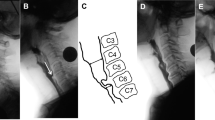Abstract
The nature of the swallowing impairment in patients with sporadic inclusion body myositis (s-IBM) has not been well characterized. In this study, we examined ten consecutive s-IBM patients using videofluoroscopy (VF) and computed pharyngoesophageal manometry (CPM). The patients were divided into two groups: patients with complaint and without complaint of dysphagia. VF results indicated pharyngeal muscle propulsion (PP) at the hypopharyngeal and upper esophagus sphincter (UES) in all s-IBM patients. Patients without complaint of dysphagia showed a mild degree of PP, whereas a severe form of PP was observed in patients with complaint of dysphagia. CPM revealed that negative pressure during UES opening was not observed in the s-IBM patients with complaint of dysphagia. Incomplete opening and PP at the UES were observed in all s-IBM patients. These results indicate that the dysphagic processes occur subclinically in s-IBM patients who may not report swallowing impairments.



Similar content being viewed by others
References
Lotz BP, Engel AG, Nishino H, Stevens JC, Litchy WJ (1989) Inclusion body myositis. Observations in 40 patients. Brain 112(Pt 3):727–747
Houser SM, Calabrese LH, Strome M (1998) Dysphagia in patients with inclusion body myositis. Laryngoscope 108:1001–1005
Wintzen AR, Bots GT, de Bakker HM, Hulshof JH, Padberg GW (1988) Dysphagia in inclusion body myositis. J Neurol Neurosurg Psychiatry 51:1542–1545
Danon MJ, Friedman M (1989) Inclusion body myositis associated with progressive dysphagia: treatment with cricopharyngeal myotomy. Can J Neurol Sci 16:436–438
Dietz F, Logeman JA, Sahgal V, Schmid FR (1980) Cricopharyngeal muscle dysfunction in the differential diagnosis of dysphagia in polymyositis. Arthritis Rheum 23:491–495
Kagen LJ, Hochman RB, Strong EW (1985) Cricopharyngeal obstruction in inflammatory myopathy (polymyositis/dermatomyositis). Report of three cases and review of the literature. Arthritis Rheum 28:630–636
Griggs RC, Askanas V, DiMauro S, Engel A, Karpati G, Mendell JR, Rowland LP (1995) Inclusion body myositis and myopathies. Ann Neurol 38:705–713
Rosenbek JC, Robbins JA, Roecker EB, Coyle JL, Wood JL (1996) A penetration-aspiration scale. Dysphagia 11:93–98
Seaman WB (1966) Cineroentgenographic observations of the cricopharyngeus. Am J Roentgenol Radium Ther Nucl Med 96:922–931
Kornblum C, Broicher R, Walther E, Seibel P, Reichmann H, Klockgether T, Herberhold C, Schroder R (2001) Cricopharyngeal achalasia is a common cause of dysphagia in patients with mtDNA deletions. Neurology 56:1409–1412
Shapiro J, Martin S, DeGirolami U, Goyal R (1996) Inflammatory myopathy causing pharyngeal dysphagia: a new entity. Ann Otol Rhinol Laryngol 105:331–335
Cook IJ, Blumbergs P, Cash K, Jamieson GG, Shearman DJ (1992) Structural abnormalities of the cricopharyngeus muscle in patients with pharyngeal (Zenker’s) diverticulum. J Gastroenterol Hepatol 7:556–562
Verma A, Bradley WG, Adesina AM, Sofferman R, Pendlebury WW (1991) Inclusion body myositis with cricopharyngeus muscle involvement and severe dysphagia. Muscle Nerve 14:470–473
Suzuki N, Aoki M, Mori-Yoshimura M, Hayashi YK, Nonaka I, Nishino I (2011) Increase in number of sporadic inclusion body myositis (sIBM) in Japan. J Neurol. doi:10.1007/s00415-011-6185-8
St Guily JL, Moine A, Perie S, Bokowy C, Angelard B, Chaussade S (1995) Role of pharyngeal propulsion as an indicator for upper esophageal sphincter myotomy. Laryngoscope 105:723–727
Cherin P, Pelletier S, Teixeira A, Laforet P, Simon A, Herson S, Eymard B (2002) Intravenous immunoglobulin for dysphagia of inclusion body myositis. Neurology 58:326
Liu LW, Tarnopolsky M, Armstrong D (2004) Injection of botulinum toxin A to the upper esophageal sphincter for oropharyngeal dysphagia in two patients with inclusion body myositis. Can J Gastroenterol 18:397–399
Author information
Authors and Affiliations
Corresponding author
Rights and permissions
About this article
Cite this article
Murata, Ky., Kouda, K., Tajima, F. et al. A dysphagia study in patients with sporadic inclusion body myositis (s-IBM). Neurol Sci 33, 765–770 (2012). https://doi.org/10.1007/s10072-011-0814-y
Received:
Accepted:
Published:
Issue Date:
DOI: https://doi.org/10.1007/s10072-011-0814-y




